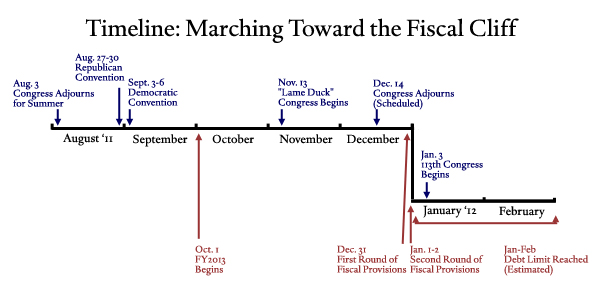Council on Foreign Relations Primes Readers on the Fiscal Cliff
The Council on Foreign Relations has joined in on those warning of the dangers of the fiscal cliff due to hit early January and unsustainable rising levels of debt. The helpful "backgrounder" piece explains both the domestic, national security, and economic consequences of the cliff as well as some context to how we got to this point. If you haven't already seen our updated fiscal cliff paper, the appendices provide detailed analysis of the cliff's impact on the economy, defense spending, discretionary spending, taxes and Medicare.
Adding some clarity to the end of the year, CFR provides a timeline of the rapid sequence of events leading up to the cliff. The first round of fiscal provisions on December 31 includes the revenue measures—the expiration of the Bush tax cuts and the expiration of the payroll tax cuts—but also the sunset of unemployment benefits and payments to Medicare physicians undergoing a 27 percent cut with the expiration of the doc fix. Two days later on January 2, the sequester is due to go into effect. Finally, the debt ceiling is expected to be breached sometime in January through February.

Notice the small one-month window between when the "Lame Duck Congress" begins and adjourns. It will it difficult to address all of the decisions that will need to be made in a comprehensive debt reduction plan; thus, lawmakers should get to work as soon as possible.
While the cliff will have a damaging effect on the economy, long-run projections show that the rising federal debt has the potential to do far greater damage. The cliff has the potential to help our long-term prospects, but only if it forces Congress to come together with a bipartisan deal. As we said in our paper, quoted by the CFR, "Failure to make the hard but necessary choices now on our own terms will lead to much harder and more severe choices later."
The CFR backgrounder piece can be found here, and our cliff paper is available here.

